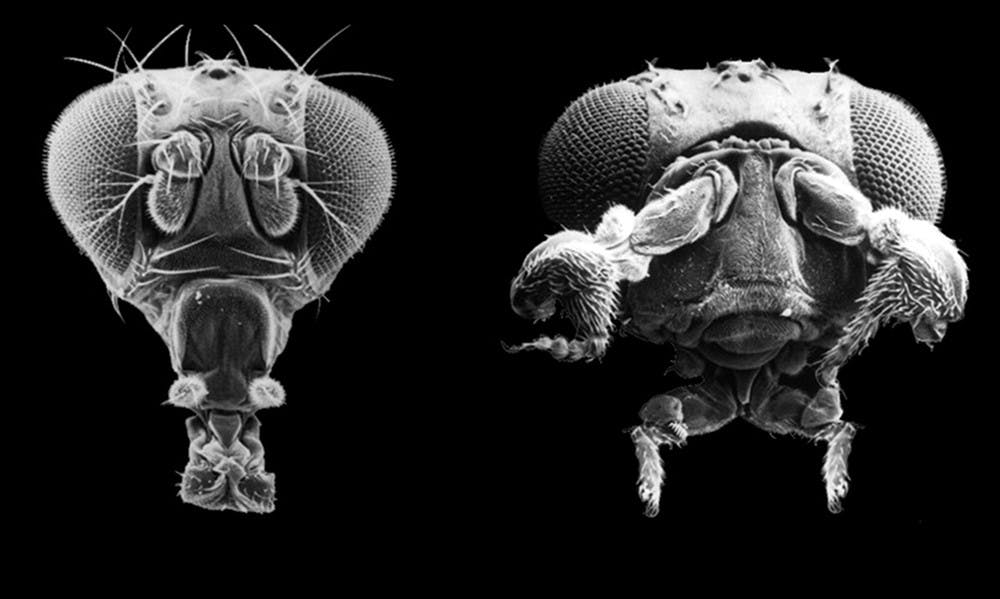Melissa Phelps stares into a microscope. Under her gaze, dozens of fruit flies lay on their sides, legs and antennas twitching. They’re not dead, just sleeping.
She looks at the pile, searching for flies with straight wings, not curly ones.
She separates a few straight-winged flies from the group with a flat metal tool. Eventually they’ll wake up, breed and create a new mutant line.
Phelps, 39, altered the flies’ DNA — the genetic makeup that makes the fly what it is. The DNA determines whether it has straight or curly wings, red or white eyes and whether it will live a long healthy life or a short sick one.
In these flies, Phelps altered one specific gene using a new method called CRISPR.
CRISPR was unveiled in 2013 as a tool for genome editing, causing a wave in the biology community. It allowed biologists to target genes like never before.
Theoretically, scientists could tinker with insects and animals — make their eyes different colors, alter their body size or shape. Diseases could be stopped before they had the chance to develop. Plant genes could be edited to advance breeding.
The possibilities seemed endless.
But using CRISPR in humans could be catastrophic. Many believe this new system would allow scientists to create the perfect human, to create man in his own image. Scientists could choose eye color, hair color, body build or height. Because of these abilities, the scientific community and the public are wary.
To those who fear CRISPR, the possibility of eugenics is a reason to stop working with the method altogether.
But on the fifth floor of Jordan Hall, Phelps and her fellow researchers are focused on the genes of tiny fruit flies.
***
Thomas Kaufman sits in his office, surrounded by his work.
Above him, movie posters for “The Fly,” “The Fly II” and “The Curse of the Fly” hang on his wall. All of the films are horror movies — people turning into flies, experiments gone wrong, mad scientists creating new, horrifying mutants.
For Kaufman, 71, science started with innocent observation. Growing up in Los Angeles, he rode his bike to Griffith Park and collected crayfish, tadpoles and frogs. He brought them home to observe how they lived and watched the tadpoles slowly metamorphose into adult frogs.
“I was a science nerd as a kid,” Kaufman said. “I just wanted to know how things worked.”
In college, Kaufman worked in a fly lab, washing bottles and thin glass tubes and making fly food, a type of cornmeal mush.
“I was poor,” Kaufman said. “I actually ate fly food. I just left out some of the chemicals you put in it for the flies, and I had a bowl of that for breakfast.”
After earning his post-doctorate from the University of British Columbia, he came to IU in 1976.
Ten years later, a fly geneticist in California was retiring and planned to throw away more than 1,500 mutant lines of fruit flies.
Instead, Kaufman took them and helped establish IU’s fruit fly stock center, which has now become one of the largest in the world. It has more than 50,000 mutant lines, which are generations of flies with certain genes that have been deleted or altered.
Greater access to fruit flies meant more research could be done at IU. One of Kaufman’s early experiments was studying the antenna gene. He deleted the gene Antennapedia and, without the gene in its sequence, the fly grew legs out of its head.
This attracted attention when producers of the show “The X-Files” came to see Kaufman’s lab at IU. Their visit was the basis for the 1997 episode “The Post-Modern Prometheus.”
In the episode, FBI investigators Fox Mulder and Dana Scully go to the fruit fly research lab of Dr. Francis Pollidori, a mad scientist based on Kaufman.
Mulder and Scully visit Pollidori’s cluttered lab, filled with shelves of glassware and books. Lightning constantly flashes in the window; thunder roars outside.
Pollidori takes the investigators into his main laboratory and shows them pictures of his most recent research on a television screen.
The investigators were stunned.
“This fly has legs...” Mulder said.
“Growing out of its mouth,” Scully finished.
“Why would you do that?” Mulder asked Dr. Pollidori.
“Because I can.”
“Can that be done in humans?” Mulder asks.
“That would go against every scientific convention,” Pollidori said.
“But could it be done?” Mulder asks again.
“Theoretically.”
Since 1995, IU scientists have been testing one gene in the fruit fly called centrosomin, nicknamed Cnn.
Cnn is involved with cell replication, which causes one embryo to multiply into thousands of cells. By partially or entirely deleting the gene, Kaufman, Phelps and associate researcher Robert Eisman can see the effects of these deletions on the fruit fly.
Before, deleting a gene was complicated. When researchers tried to delete one gene, they ended up destroying larger parts of the DNA. Now, with CRISPR, researchers can be incredibly specific, targeting not just one gene, but certain parts of it. They can go deeper into DNA than ever before.
***
The lab smells like rotten food. The fruit fly researchers are growing thousands of larvae for their fly stocks. On every Monday and Thursday, 3,000 to 5,000 stocks are sent to labs all over the world. When that many are concentrated in one area, there’s nothing to do about the smell that overtakes the entire floor.
Eisman, 58, walks into the lab and turns to Phelps.
“Someone just told me they cleaned the fridge twice, thinking that something had gone bad in there,” he said.
“Oh really?” Phelps laughs.
“I told them, ‘No it’s just the smell of science.’”
Eisman and Phelps sit down to gaze at their flies again.
They don’t notice a fluorescent light flickering overhead.
On the microscope stage are dozens of small flies, legs and antennas twitching under the bright yellow light.
“They’re an amazing little organism,” Eisman said.
The fly life cycle lasts only 10 days. A single adult female fly can lay up to 500 eggs in her lifetime. Each egg is a half of a millimeter wide, narrower than the edge of a dime.
Eventually, they hatch into white-colored larvae and transform into an adult fruit fly.
On each side of the head are red eyes, which look like graph paper with hundreds of squares from far away. But when scientists look in their microscopes, they can see the individual facets.
Eisman and Phelps can alter every part of the fly. Moving genes or deleting them causes tangible effects in the fly’s life cycle. And because one fly can lay 500 eggs, scientists can study thousands at a time at an incredibly low cost.
Scientists can inject fly eggs with a genome and in two weeks have an entirely new generation. Two weeks after that, it’s multiplied again and they have the base of a stock. If they used a mouse, the same process would take at least a year.
But the work is mundane and repetitive.
Eisman and Phelps quickly drag sleeping flies from the pile, reorganizing them into narrow tubes.
In a week’s time, Phelps hopes to find males that are sterile. If she does, she’ll know that she successfully deleted Cnn from the fly’s DNA and will know more about the gene than she did before.
After Phelps pushes the flies into her glass tube, she shoves a small piece of cotton in the top to keep the flies from escaping. She picks up a black Sharpie and writes the date on the tube, returning it to a plastic box.
She has to wait to see which mutant lines came out the way she planned.
But she only needs one.
***
Around the world, scientists are testing the limits of CRISPR.
In China, scientists used CRISPR to edit the DNA of abnormal human embryos, trying to prevent a blood disease called beta-thalassemia.
The Chinese scientists reported some success, but also some unexpected mutations. Their conclusion: it’s still too early to use CRISPR in human embryos.
The experiments sparked worldwide debate. International science journals refused to publish the research.
Gene editing in humans opens the door for eugenics, or the altering of certain genes to single out desired human traits.
For most people, “eugenics” evokes memories of Nazis and their quest for a pure Aryan race. Even in the United States, more than 7,000 people were sterilized between 1920 and 1980, mainly the mentally ill, disabled, African-American and homeless.
Using CRISPR, many believe scientists could create specific traits in humans. In the future, those who could afford it would be able to design their baby to be athletic, intelligent or immune to certain diseases.
Afraid of the consequences, scientists from all over the world called for an end to human testing involving CRISPR until solid rules are established.
On Sept. 22, 2015, a UK researcher requested to modify genes in human embryos to better understand early development. The Human Fertilisation and Embryology Authority granted their request last week.
While the world debates, Kaufman and his team are focused on the fruit fly, specifically the gene Cnn.
With each Cnn deletion, Kaufman and his researchers learn more about the gene itself, which could possibly lead to a big discovery. But those are rare.
“Not all of it is going to pay off,” Eisman said. “But almost everything gives us a better understanding.”
***
After a few weeks, Phelps had more than just one.
Out of the 178 mutant lines she tested, three lines had sterile male flies, which means her deletion was successful.
By deleting two small portions of Cnn, she created new mutant lines she can further test. Now that Phelps knows she has a deletion, she can go further into the gene and figure out exactly which amino acids are missing.
After that, Phelps, Kaufman and Eisman can design more experiments around that deletion, observing changes to the tiny white eggs that the females will lay.
Phelps and Eisman don’t expect the eggs to hatch without this portion of the gene.
They aren’t certain, but further tests will tell.
***
Eisman stares into a one-and-half inch tube, trying to make out the liquid inside.
“You’re trying to understand something you can’t see,” he said. “It gets pretty frustrating.”
Eisman came to IU in 1998 as a graduate student and never left. He’s been working in Kaufman’s lab for 17 years, studying Cnn.
Only after they understand Cnn in flies can they understand the same gene in humans. Their research could help drug companies develop medicine for Down Syndrome. It could help doctors understand the specific cause for Turner’s Syndrome. Or it could prevent a miscarriage.
With the help of CRISPR, they can begin to understand the inner workings of not only the fruit fly, but of humans too.
Designer babies are impossible to create at the level scientists are using CRISPR. The human genome is incredibly complex. Even small human features, such as eye color, are controlled by multiple genes.
“That’s what science appears to be doing — playing God,” Eisman said. “It’s easier to deny than try to understand.”
When people don’t understand, research labs run into trouble. The thought of using CRISPR scares some people, who want use of the method, especially on human embryos, to stop.
“They want to support something they understand,” Eisman said. “They think, ‘Why should my hard-earned money go toward studying a fruit fly?’”
But scientists can take disease-causing human genes and put them into a fly. Then they observe what happens and figure out how to block the disease.
Those discoveries start with basic research, which doesn’t always translate directly to human medicine.
“Some of the biggest discoveries come from basic research,” Eisman said. “Everything we have today that we take for granted came from basic research. And most great discoveries are mistakes.”
***
Kaufman, Phelps and Eisman spend hours each day with fruit flies, just to learn more about one gene.
They’re constantly fascinated by the ways they can manipulate a gene — life itself — even in the smallest of organisms.
Still, they have no illusions of grandeur.
The research isn’t about changing the human genome. It isn’t about creating the perfect baby. It’s about helping mankind learn through a fruit fly.
On the microscope stage in front of Eisman, one fly wakes up.
It soars above the microscope and disappears in the clutter of the lab.




